- Python Basic Programs
- Python Program Examples
- Python Print Hello World
- Python Get Input from User
- Python Add Two Numbers
- Add Subtract Multiply Divide
- Python Check Even or Odd
- Python Check Prime or Not
- Python Check Alphabet or Not
- Python Check Vowel or Not
- Python Check Leap Year or Not
- Check Reverse equal Original
- Check Positive Negative Zero
- Python Check Armstrong or Not
- Python Check Palindrome or Not
- Python Check Perfect Number
- Python Find Reverse of Number
- Python Count Digits in Number
- Python Add Digits of Number
- Sum of First and Last Digits
- Python Product of Mid Digits
- Sum of Squares of Digits
- Interchange Digits of Number
- Python Sum of n Numbers
- Python Print ASCII Values
- Python Swap Two Numbers
- Python Swap Two Variables
- Python Fahrenheit to Celsius
- Python Celsius to Fahrenheit
- Python Display Calendar
- Python Days into Years, Weeks
- Find Largest of Two Number
- Find Largest of Three Number
- Python Print Fibonacci Series
- Generate Armstrong Numbers
- Python Make Simple Calculator
- Python Add Binary Numbers
- Binary Number Multiplication
- Python Mathematical Programs
- Find Sum of Natural Numbers
- Find Average of n Numbers
- Python Print Multiplication Table
- Print Table using Recursion
- Python Find Average Percentage
- Python Find Grade of Student
- Find Square Root of Number
- Python Print Prime Numbers
- Find Numbers Divisible by
- Python Find Factors of Number
- Python Find Factorial of a Number
- Python Find HCF & LCM
- Python Kilometres to Miles
- Python Find Area of Square
- Python Find Area of Rectangle
- Python Find Area of Triangle
- Python Find Area of Circle
- Python Find Perimeter of Square
- Find Perimeter of Rectangle
- Python Find Perimeter of Triangle
- Find Circumference of Circle
- Python Simple Interest
- Python Solve Quadratic Equation
- Python Different Set of Operations
- Python Display Powers of 2
- Python Find nCr & nPr
- Python Pattern Programs
- Python Print Pattern Programs
- Python Print Diamond Pattern
- Python Print Floyd's Triangle
- Python Print Pascal's Triangle
- Python List Programs
- Python Count Even/Odd in List
- Python Positive/Negative in List
- Python Even Numbers in List
- Python Odd Numbers in List
- Python Sum of Elements in List
- Sum of Odd/Even Numbers
- Python Element at Even Position
- Python Element at Odd Position
- Python Search Element in List
- Python Largest Number in List
- Python Smallest Number in List
- Python Second Largest in List
- Python Second Smallest in List
- Python Insert Element in List
- Python Delete Element from List
- Python Multiply Numbers in List
- Swap Two Elements in List
- Python 1D Array Program
- Python Linear Search
- Python Binary Search
- Python Insertion Sort
- Python Bubble Sort
- Python Selection Sort
- Remove Duplicates from List
- Python Reverse a List
- Python Merge Two List
- Python Copy a List
- Python Conversion Programs
- Python Decimal to Binary
- Python Decimal to Octal
- Python Decimal to Hexadecimal
- Python Binary to Decimal
- Python Binary to Octal
- Python Binary to Hexadecimal
- Python Octal to Decimal
- Python Octal to Binary
- Python Octal to Hexadecimal
- Python Hexadecimal to Decimal
- Python Hexadecimal to Binary
- Python Hexadecimal to Octal
- Python Matrix Programs
- Python Add Two Matrices
- Python Subtract Two Matrices
- Python Transpose Matrix
- Python Multiply Matrices
- Python String Programs
- Python Print String
- Python Find Length of String
- Python Compare Two Strings
- Python Copy String
- Python Concatenate String
- Python Reverse a String
- Python Swap Two Strings
- Python Uppercase to Lowercase
- Python Lowercase to Uppercase
- Python Check Substring in String
- Python Count Character in String
- Count Repeated Characters
- Python Count Word in Sentence
- Python Count Each Vowels
- Python Capitalize Character
- Python Capitalize Word in String
- Python Smallest/Largest Word
- Remove Spaces from String
- Remove Duplicate Character
- Remove Vowels from String
- Remove Punctuation from String
- Python Remove Word in String
- Python Remove Duplicate Words
- WhiteSpace to Hyphens
- Replace Vowels with Character
- Replace Character in String
- Python Sort String in Alphabetical
- Sort Word in Alphabetical Order
- Extract Number from String
- Python Check Anagram Strings
- Python File Programs
- Python Read a File
- Python Write to File
- Python Append Text to File
- Python Copy Files
- Python Merge Two Files
- Python Counts Characters in File
- Python Count Words in File
- Python File Content in Reverse
- Python Lines Contains String
- Python Delete Line from File
- Python Capitalize Word in File
- Python Replace Text in File
- Replace Specific Line in File
- Python Find Size of File
- Python List Files in Directory
- Python Delete Files
- Python Misc Programs
- Python Reverse a Tuple
- Python Merge Two Dictionary
- Python bytes to String
- Python bytearray to String
- Generate Random Numbers
- Python Print Address of Variable
- Python Print Date and Time
- Python Get IP Address
- Python Shutdown/Restart PC
- Python Tutorial
- Python Tutorial
Python Program to Convert Hexadecimal to Octal
In this article, we've created some programs in Python, to convert hexadecimal number entered by user to its octal equivalent. Here are the list of programs:
- Hexadecimal to Octal using while Loop
- Using int() and oct() Methods
- Using user-defined Function
- Using Class and Object
Note - Before creating these programs, if you're not aware about steps used for the conversion, then refer to Hexadecimal to Octal Steps and Formula to get every required things.
Hexadecimal to Octal using while Loop
To convert hexadecimal to octal number in Python, you have to ask from user to enter any number in hexadecimal number system, then convert that number into its octal equivalent as shown in the program given below:
print("Enter the Hexadecimal Number: ") hexdecnum = input() chk = 0 decnum = 0 hexdecnumlen = len(hexdecnum) hexdecnumlen = hexdecnumlen-1 i = 0 while hexdecnumlen>=0: rem = hexdecnum[hexdecnumlen] if rem>='0' and rem<='9': rem = int(rem) elif rem>='A' and rem<='F': rem = ord(rem) rem = rem-55 elif rem>='a' and rem<='f': rem = ord(rem) rem = rem-87 else: chk = 1 break decnum = decnum + (rem * (16 ** i)) hexdecnumlen = hexdecnumlen-1 i = i+1 if chk==0: i = 0 octnum = [] while decnum!=0: rem = decnum%8 octnum.insert(i, rem) i = i+1 decnum = int(decnum/8) print("\nEquivalent Octal Value is: ") i = i-1 while i>=0: print(octnum[i], end="") i = i-1 print() else: print("\nInvalid Input!")
Here is its sample run:
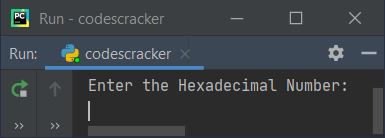
Now supply the input say 23E5F as a hexadecimal number, then press ENTER key to convert and
print its equivalent octal value as shown in the snapshot given below:
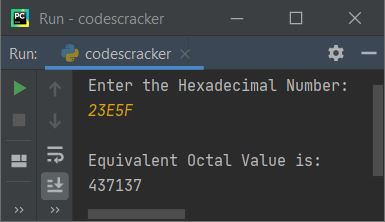
In above program, the block of code inside while loop is used to convert given hexadecimal number to its equivalent decimal value. And the block of code inside if (if of if chk==0:) is used to convert decimal value to its equivalent octal value. That means, hexadecimal gets converted into its octal equivalent in indirect way.
Note - To get in-depth idea about the working of code used for hexadecimal to decimal conversion, refer to Python Hexadecimal to Decimal
Note - To get in-depth idea about the working of code used for decimal to octal conversion, refer to Decimal to Octal.
Note - You can also prefer, hexadecimal to binary, then binary to octal way to do the job. It is up to you.
Modified Version of Previous Program
This is the modified version of previous program, uses end= to skip printing of an automatic newline using print(). That is, using end, we've received the input in same line where the message Enter Hexadecimal Number: is printed:
print("Enter Hexadecimal Number: ", end="") hnum = input() chk = dnum = i = 0 hlen = len(hnum) - 1 while hlen>=0: if hnum[hlen]>='0' and hnum[hlen]<='9': rem = int(hnum[hlen]) elif hnum[hlen]>='A' and hnum[hlen]<='F': rem = ord(hnum[hlen]) - 55 elif hnum[hlen]>='a' and hnum[hlen]<='f': rem = ord(hnum[hlen]) - 87 else: chk = 1 break dnum = dnum + (rem * (16 ** i)) hlen = hlen - 1 i = i+1 if chk==0: i = 0 onum = [] while dnum != 0: onum.insert(i, dnum % 8) i = i + 1 dnum = int(dnum / 8) print("\nEquivalent Octal Value = ", end="") i = i - 1 while i >= 0: print(onum[i], end="") i = i - 1 print() else: print("\nInvalid Input!")
Here is its sample run with hexadecimal number input 123F:
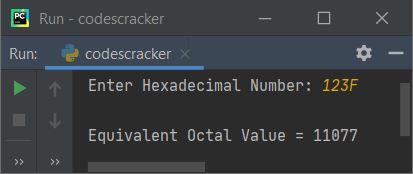
Hexadecimal to Octal using int() and oct()
This program uses int() and oct() methods to do the job. The int() method is used to return integer (decimal) equivalent of value passed as its argument. And the oct() method is used to return octal equivalent of value passed as its argument.
print("Enter Hexadecimal Number: ", end="") hnum = input() onum = int(hnum, 16) onum = oct(onum) print("\nEquivalent Octal Value = ", onum)
Here is its sample output after supplying 45EA as hexadecimal input:
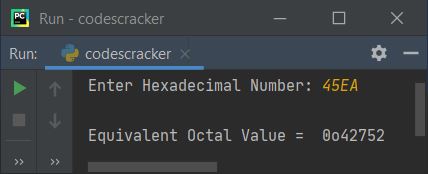
Note - If you want to skip first two characters from octal number, just add [2:] after onum while printing. That is, replace the following statement:
print("\nEquivalent Octal Value = ", onum)
with the statement given below:
print("\nEquivalent Octal Value = ", onum[2:])
after replacing, now the output looks like after re-executing the program and supplying the same user input:
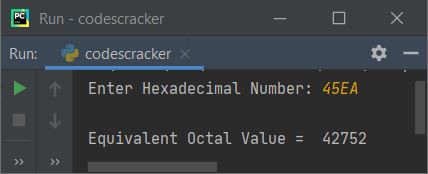
Hexadecimal to Octal using Function
Now this program is created using a user-defined function named HexToOct() and two predefined methods namely oct() and int() to do the same job as previous program has done.
def HexToOct(h): return oct(int(h, 16)) print("Enter Hexadecimal Number: ", end="") hnum = input() onum = HexToOct(hnum) print("\nEquivalent Octal Value = ", onum[2:])
Hexadecimal to Octal using Class
This is the last program of this article, created using a class named fresherearth. That is, inside the class, we've defined a member function named HexToOct(). We have created an object named obj of this class to access its member function named HexToOct() using dot (.) operator.
class fresherearth: def HexToOct(self, h): return oct(int(h, 16)) print("Enter Hexadecimal Number: ", end="") hnum = input() obj = fresherearth() onum = obj.HexToOct(hnum) print("\nEquivalent Octal Value = ", onum[2:])
Same Program in Other Languages
« Previous Program Next Program »